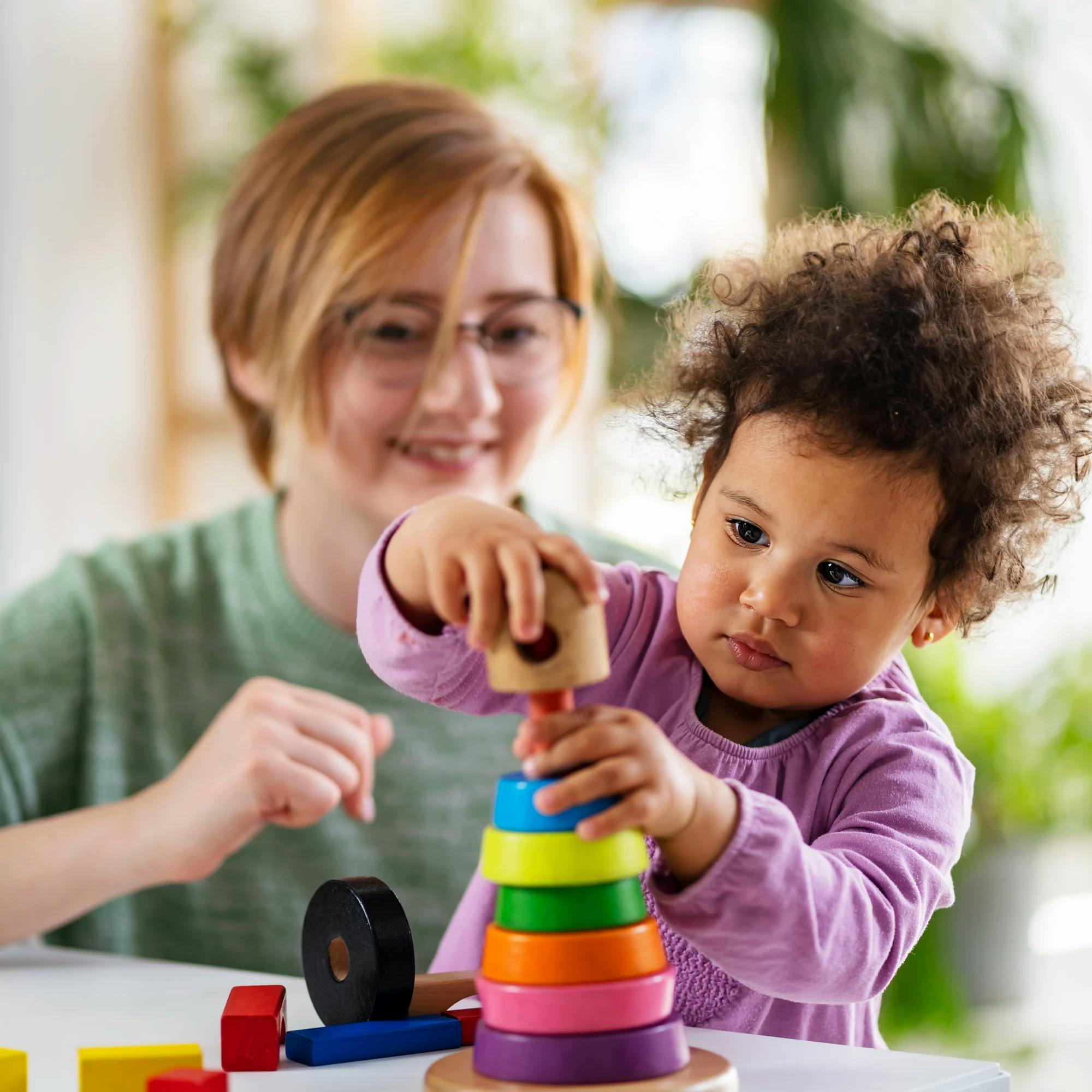
10 Tips to Help Autistic Children Talk and Improve Their Expressive Language
 Alexis Irazoque, M.S., CCC-SLP
Alexis Irazoque, M.S., CCC-SLP
If your autistic child is nonverbal or has trouble communicating, you may be looking for ways to help them talk. There are many ways you can help an autistic child with language, both with speech therapy and with at-home activities.
Expressive language is how we express our wants, needs, and thoughts to others. That includes using both words and nonverbal communication, such as pointing. Many children diagnosed with autism spectrum disorder (ASD) struggle to use expressive language. They may talk very little for their age, or not at all. They may have trouble starting or maintaining a conversation. Some autistic children repeat words or phases they just heard, which is called echolalia. Children who repeat these phrases may be gestalt language processors. Speech therapists use a variety of activities and techniques to help autistic children build their expressive language skills. Here are 10 tips you can try at home to help your child talk.
Personalized care for your child
We support autistic children for who they are and help them build new skills. Get matched with a licensed speech therapist today.
 Get started
Get started1. Get silly to prompt your child to imitate you
Autistic kids often need increased stimulation in order to respond. Ideally we want them to use words to make requests, comment on what they see, and say the names of things. However, sometimes we need to start with the basics. This involves increasing your child’s imitation skills. The more your child copies or repeats what you do and say, the more likely they’ll be able to do it themselves!
One helpful trick: Stop thinking like an adult and start thinking like a child. What makes your kiddo laugh? What engages them? Maybe a silly face, or a funny sound like blowing a raspberry or mooing like a cow. Do these activities often with your child, and encourage them to imitate you.
While your child may struggle with direct imitation or eye contact, they're more likely to follow your lead in the mirror.
Another great activity to increase verbal imitation is spending time in front of a mirror. While an autistic child may struggle with direct imitation or eye contact, they're more likely to follow your lead in the mirror. Try to add mirror time to your child’s usual routines, like taking a bath or getting ready for bed.
In addition to helping with imitation, spending a few minutes every day making silly faces and sounds in the mirror will expand your child's attention and focus. We want them to feel comfortable trying to imitate. Seeing you being silly gives them the green light to try!
2. Go low-tech with less screen time
Let’s face it, parents are busy. And sometimes it can be hard to keep an autistic child content and occupied throughout the day.
Caregivers often remark how easily their toddler can navigate their device to find their favorite videos. They may also enjoy pushing buttons and activating the lights and sounds of a favorite toy. But does all this promote language?
Studies have proven that reducing screen time and electronic toy usage increases a child’s language growth. Often, an autistic child is not functionally using a device; rather, they are "stimming" on it. This means they’re scrolling or tapping in a cause-and-effect way, rather than completing a task.
For instance, they may have a favorite fire truck that makes a sound or lights up when a button is pressed. Pressing the button over and over again holds their attention. But ideally, we want the child to make that siren sound themselves, instead of just hearing it!
While limiting screen time can be tough, it encourages a child to be creative and make sounds on their own.
As another example, your child may enjoy an online video so much they watch it repeatedly. While it’s impressive when kids can navigate devices easily and enjoy the characters on screen, their focus should be on experimenting with their own sounds and words, instead of simply listening to others.
Limiting screen time can be tough, but it encourages a child to be creative and make sounds on their own. Try removing the batteries from the fire truck and see if your child starts making the siren sound. You might be surprised!


3. Use simple sign language to help your autistic child communicate
You may be thinking, “Sign language? But my child isn’t hard of hearing!” The truth is, in early intervention, and even when working with older autistic children, speech therapists often use basic sign language as a method of communication.
Why use signs when our goal is to help children talk? Because it’s often easier to make a gesture than it is to plan the verbal production of that same word, especially for a toddler. Typically, as the child begins to use words, these gestures fade out.
Start teaching gestures for basic words like more, open, all done, and help. These are all easy to imitate. If your child allows, place your hand over theirs and guide them through the motions to help them learn.
4. Give your child chances to ask for things
An autistic child can often appear self-sufficient. They may know where their favorite toys are, or they can go to the cupboard and get their own snack. In short, sometimes they don’t even need to use words or nonverbal language to get what they want.
This may sound odd, but one trick to encourage your child to use language is to get them a little frustrated. We know what you’re thinking: What parent wants a frustrated kid? Well, a little bit of frustration can actually motivate a child to use words. While being self-sufficient is fantastic, being able to ask for an apple is even better.
For instance, let's say your child wants a snack, and you know they want some crackers. Give them a choice between crackers and something they definitely do not want. Hold both up and say, “Do you want the crackers or the carrots?” This gets them in the habit of pointing to what they want. Then, you can quickly follow up with verbal confirmation: “You want the crackers!”
Eventually, try holding out until they use a sound or word to say what they want. “Did you want the carrots or the crackers? Good pointing, but can you use your words? Carrot or crackers?”
When they speak, even if it doesn’t sound perfect, this is great progress! You can respond, “I heard you. You wanted the crackers! That was a great try! Thank you for using your words. Here you go!”

5. Teach your autistic child to combine words into phrases
If your child has begun using single words and gestures, you can guide them to the next step in their language development. We want to begin combining the words they use into simple phrases.
For example, the words “more” and “drink” become “more drink.” Combining two established words and/or gestures, confirming your child's attempt, and praising their efforts will encourage them to keep using more complex language to express their needs.
6. Put two speech therapy techniques together
In our tips above, we discussed how to provide choices and encourage your child to use longer phrases. Let’s try putting these two speech therapy techniques together.
Say you’re giving your child a choice of two activities: “Do you want the ball or bubbles? … You want bubbles!”
Before giving your child the bubbles, make sure the lid is on tight. They may feel frustrated trying to get it open, which should encourage them to hand it back to you. Then you can say, “You need me to open?”
Again, you’re creating another chance for your child to request, with either words or a simple gesture.
If your child is expecting you to blow the bubbles, don’t do it right away. Wait expectantly until they ask for it, then say, “More bubbles?” Even a head nod can lead to a child saying “yes." The takeway here: Create as many opportunities as you can throughout the day for your child to practice communicating.


7. Sing songs to help your autistic child use their voice
It's helpful to give autistic kids lots of chances to use their voice. Music is a great way for children to discover their voice and experiment with sound.
Does your child have a favorite theme song from a TV show? Do they love “Head, Shoulders, Knees, and Toes?” Children’s songs are a good choice, especially those that include simple, repetitive gestures.
If your child has a hard time staying in one place, add some wiggles, hops, or dance moves to the song. If they aren’t singing a whole line, leave it open-ended for them to complete. For example, you could sing, “Old MacDonald had a farm…," then pause, giving them the chance to complete it.
Add some extra fun by grabbing pots and pans and banging along to the rhythm. Songs are an easy way to encourage your child to vocalize and increase their expressive language.


8. Use visuals to help your autistic child communicate
For some autistic kids, communicating with words is a big challenge. While we can encourage them to speak, sometimes we need to think of other ways to help them share their thoughts.
One technique is to set up a board that displays pictures of items they can request, such as foods, toys, and activities. It's important to model, or say, these words for your child. For example, you can say, “I want the book,” and put the picture of the book on the board. Then ask your child what they want, and see if they put a picture on the board. “You want to play trains! Good idea!”


9. Use positive reinforcement: "You did it!"
We all respond to praise, support, and other forms of positive reinforcement. Encourage your child to communicate in whatever form that takes, and praise them when they try. This way you're creating a safe environment for them to experiment.
Whether it's pointing, using a picture board, or using a word or gesture, it's the attempt that matters. While the goal for your child is to better express themselves, your job is to encourage it!
10. Track the words your child is using
Try to keep track of the new words your child is using. For example, you might keep a list of words in your phone, or attach it to the fridge. This will help you expand on your child’s expressive language. For example, if they’re saying “juice,” you can try to teach “juice, please.”
You’ll also be able to tell which new words might be helpful to introduce next. If your child is saying “shoes,” the next word to focus on might be “socks.”
Again, start with the basics and build from there. If your child is telling you “no” (for many toddlers, their favorite word!), then work on “yes.” Keeping a list of all these new words not only helps expand vocabulary, but shows how much your child has accomplished!
Speech therapy can help nonverbal children communicate
Caregivers often worry about how many words their child is using. That's often what leads them to seek a diagnosis of autism. While it's easy to get stuck on that number, the goal should always be to have a happy, healthy child who is able to express themselves.
Using these 10 tips can help create a safe environment for your child to express themselves and build their language skills. But by working with a speech therapist, you can learn techniques that are tailored to your unique child’s needs, preferences, and abilities.
Speech therapy is one of the most common therapies recommended for autistic people. For nonverbal or speech delayed autistic children, there are many ways a speech therapist can support their language growth to help them become the best, most authentic communicators they can be.
At Expressable, we work one-on-one with children, but we also partner with families to ensure they can help their child practice their new skills at home. Online speech therapy makes it easy for parents to attend alongside their child, learning speech therapy activities that are personalized to them. Plus, many kids respond well to having therapy in the comfort of a familiar place. Learn more about our approach to supporting autistic kids in our autism treatment guide.


Get matched with a speech therapist at Expressable
Speech-language pathologists are experts in supporting autistic children and their families. Click here to get matched with the right speech therapist for your family. We’re here to answer your questions and help you help your child. An important note: We believe that when speaking about any community as a whole, the best approach is to prioritize that community’s voices, needs, and preferences. Within the larger autism community, the current language preference is identity-first, which is why we use that language in our content. Expressable is committed to listening to and learning from the populations we serve. If and when their preferences change, we’ll adjust our approach accordingly.
How Expressable Can Help
Concerned your child isn't reaching age-expected milestones? Looking for communication support from a professional? Expressable is a national online speech therapy practice serving children and adults. We treat all major areas of communication and feeding, offer flexible hours including evenings and weekends, and accept most major health insurance plans. We’re proud to have earned more than 3,000 5-star reviews from our clients (4.9/5 average).
Our therapy model is centered on parent and caregiver involvement. Research proves that empowering caregivers to participate in their loved one’s therapy leads to better outcomes. That’s why we combine live, 1-on-1 speech therapy with personalized education and home practice activities for faster progress.
Communication is more than words. It’s how we share how we feel and show who we are. We’re here to help you or your child do just that.










